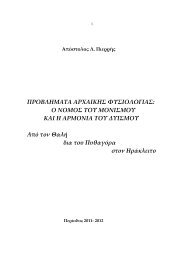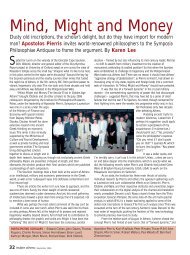APPENDIX C΄ ON DEPILATION: BODY COSMETICS IN CLASSICAL ...
APPENDIX C΄ ON DEPILATION: BODY COSMETICS IN CLASSICAL ...
APPENDIX C΄ ON DEPILATION: BODY COSMETICS IN CLASSICAL ...
Create successful ePaper yourself
Turn your PDF publications into a flip-book with our unique Google optimized e-Paper software.
570 <strong>APPENDIX</strong> <strong>C΄</strong><br />
§·Î‰·ÈÌÔÓ›ˆÓ àÓ·Ó‰ÚfiÙÂÚÔÓ ïÚÄÛı·È ÙcÓ ¯Úfi·Ó j ÙeÓ ùÁÎÔÓ ÙÔÜ<br />
ÛÒÌ·ÙÔ˜ ö¯ÂÈÓ ñapplebÚ Ùa Á˘ÌÓ¿ÛÈ·, we must suspect the substitution<br />
of the skin-tint for the beautiful and athletic built of the bodies of the<br />
Spartans. Probably Aelian had in mind the trivial remark about the<br />
healthy tint of those not eschewing physical activity, and even this, as<br />
above remarked, would rather apply to the bronze tan of those<br />
exercising in the open, not the blackened aspect of those working in<br />
the fields.<br />
In a word, it should not be forgotten that delicacy and luxurious<br />
indulgence in pleasures are not incompatible with bodily vigour and<br />
physical valour (especially in an aristocratic context). Satyros<br />
characteristically writes as follows appleÂÚd ÙÔÜ Î·ÏÔÜ \AÏÎÈ‚È¿‰Ô˘, apud<br />
Athenaeus XII, 534b: ϤÁÂÙ·È, ÊËÛ›Ó, ¬ÙÈ âÓ \IˆÓ›÷· ÌbÓ JÓ <br />
âÊ·›ÓÂÙÔ ÙÚ˘ÊÂÚÒÙÂÚÔ˜, âÓ £‹‚·È˜ ‰b ۈ̷ÛÎáÓ Î·d Á˘ÌÓ·˙fiÌÂ-<br />
ÓÔ˜ ÙáÓ £Ë‚·›ˆÓ ·éÙáÓ ÌÄÏÏÔÓ BÔÈÒÙÈÔ˜, âÓ £ÂÙÙ·Ï›÷· ‰b îappleappleÔ-<br />
ÙÚÔÊáÓ Î·d ìÓÈÔ¯áÓ ÙáÓ \AÏ¢·‰áÓ îappleappleÈÎÒÙÂÚÔ˜, âÓ apple¿ÚÙFË ‰b<br />
ηÚÙÂÚ›·Ó ηd àʤÏÂÈ·Ó âappleÈÙˉ‡ˆÓ âӛη ÙÔf˜ §¿ÎˆÓ·˜, ñappleÂÚFÉÚÂÓ<br />
‰b ηd ÙcÓ ÙáÓ £Ú÷·ÎáÓ àÎÚ·ÙÔappleÔÛ›·Ó.<br />
The general contrast between light skin tints and dark-skinned<br />
male bodies was carried a step further by its specialization in a<br />
particularly relevant area of the human body. I refer to the antithesis<br />
Ï¢Îfiapple˘ÁÔÈ - ÌÂÏ¿Ìapple˘ÁÔÈ. Due, probably, to another feat of shallow<br />
cleverness on the part of Alexandrian scholarship, the matter appears a<br />
little confused in our sources, but it really is clear enough. Among the<br />
various kinds of eagle, two prominent ones were called apple‡Á·ÚÁÔÈ and<br />
̤ϷÓ˜ or ÌÂÏ·Ó¿ÂÙÔÈ (v. Aristotle, Historia Animalium, Z, 563b5-<br />
7, and especially I, 618b17 sqq.). The latter is a wilder species (but<br />
caring for its offspring, which is an exception as Aristotle implies,<br />
618b29), smallest but strongest of the eagles (̤Ϸ˜ ÙcÓ ¯Úfi·Ó ηd<br />
̤ÁÂıÔ˜ âÏ¿¯ÈÛÙÔ˜, ÎÚ¿ÙÈÛÙÔ˜ ÙÔ‡ÙˆÓ 618b26-27), inhabiting<br />
mountains and forests (ibid.), described by Aristotle in a series of<br />
positive attributes (618b29-31): öÛÙÈ ‰b è΢‚fiÏÔ˜ ηd Âéı‹ÌˆÓ ηd<br />
ôÊıÔÓÔ˜ ηd ôÊÔ‚Ô˜ ηd Ì¿¯ÈÌÔ˜ ηd ÂûÊËÌÔ˜. It is to this kind that<br />
Achilles is compared in Ilias Φ, 251-3:<br />
ËϽ‰Ë˜ ‰’ àapplefiÚÔ˘ÛÂÓ ¬ÛÔÓ Ù’ âappled ‰Ô˘Úe˜ âÚˆ‹,<br />
·åÂÙÔÜ ÔúÌ·Ù’ ö¯ˆÓ ̤ϷÓÔ˜, ÙÔÜ ıËÚËÙÉÚÔ˜,<br />
¬˜ ı’ ±Ì· οÚÙÈÛÙfi˜ Ù üÎÈÛÙÔ˜ appleÂÙÂËÓáÓ










